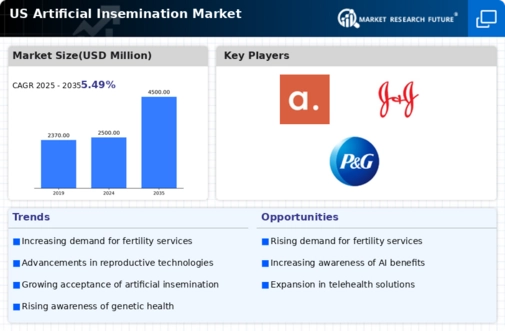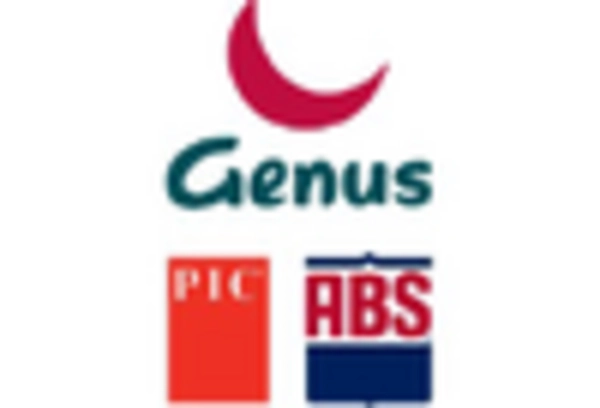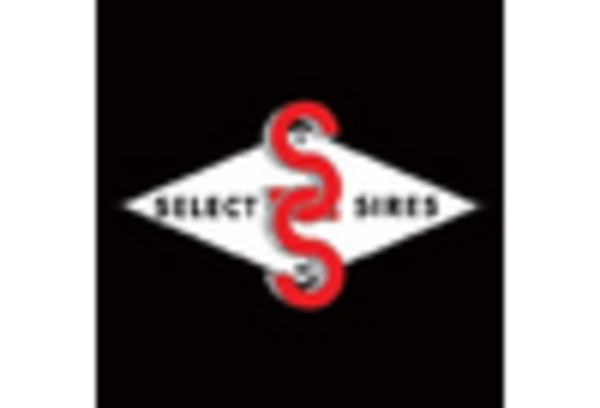Rising Infertility Rates
The increasing prevalence of infertility in the US is a primary driver for the artificial insemination market. Recent statistics indicate that approximately 10-15% of couples experience difficulties in conceiving, leading to a growing demand for assisted reproductive technologies. This trend is further exacerbated by lifestyle factors such as delayed childbearing, obesity, and environmental influences. As more individuals seek solutions to infertility, the artificial insemination market is likely to expand. The market is projected to reach a valuation of over $2 billion by 2026. This growth underscores the critical role that artificial insemination plays in addressing reproductive challenges faced by couples across the nation.
Advancements in Reproductive Technologies
Technological innovations in reproductive health are significantly influencing the artificial insemination market. Developments in techniques such as intrauterine insemination (IUI) and in vitro fertilization (IVF) have enhanced success rates, making these procedures more appealing to prospective parents. The integration of artificial intelligence and machine learning in fertility clinics is also streamlining processes, improving patient outcomes, and reducing costs. As these technologies continue to evolve, they are expected to attract more patients, thereby driving market growth. The artificial insemination market is anticipated to benefit from these advancements, with an expected increase in procedures performed annually, potentially exceeding 1 million by 2027.
Increased Investment in Fertility Clinics
The influx of investment in fertility clinics is a significant driver of the artificial insemination market. Venture capital and private equity firms are increasingly funding fertility startups and established clinics, recognizing the lucrative potential of this sector. This financial support enables clinics to expand their services, adopt cutting-edge technologies, and enhance patient care. As a result, the number of fertility clinics in the US is expected to rise, providing greater access to artificial insemination services. This trend may lead to a more competitive market landscape, ultimately benefiting consumers through improved services and pricing. The artificial insemination market could see a growth rate of 10% annually as a result of these investments.
Regulatory Changes Favoring Reproductive Health
Recent regulatory changes in the US are creating a more favorable environment for the artificial insemination market. Policies aimed at improving access to reproductive health services, including insurance coverage for fertility treatments, are being implemented. These changes are likely to reduce the financial burden on patients, making artificial insemination more accessible to a broader demographic. Additionally, regulatory support for research and development in reproductive technologies is expected to foster innovation within the industry. As these policies take effect, the artificial insemination market may experience a surge in demand, with an estimated growth of 12% over the next few years as more individuals seek these essential services.
Growing Acceptance of Assisted Reproductive Technologies
Cultural shifts towards the acceptance of assisted reproductive technologies are propelling the artificial insemination market forward. As societal norms evolve, more individuals and couples are open to exploring options like artificial insemination. This acceptance is particularly evident among same-sex couples and single parents, who increasingly view these technologies as viable pathways to parenthood. Educational campaigns and advocacy efforts have played a crucial role in normalizing these practices, leading to a rise in inquiries and procedures. The market is projected to see a 15% increase in demand over the next five years, reflecting this growing acceptance and the desire for diverse family structures.

















Leave a Comment